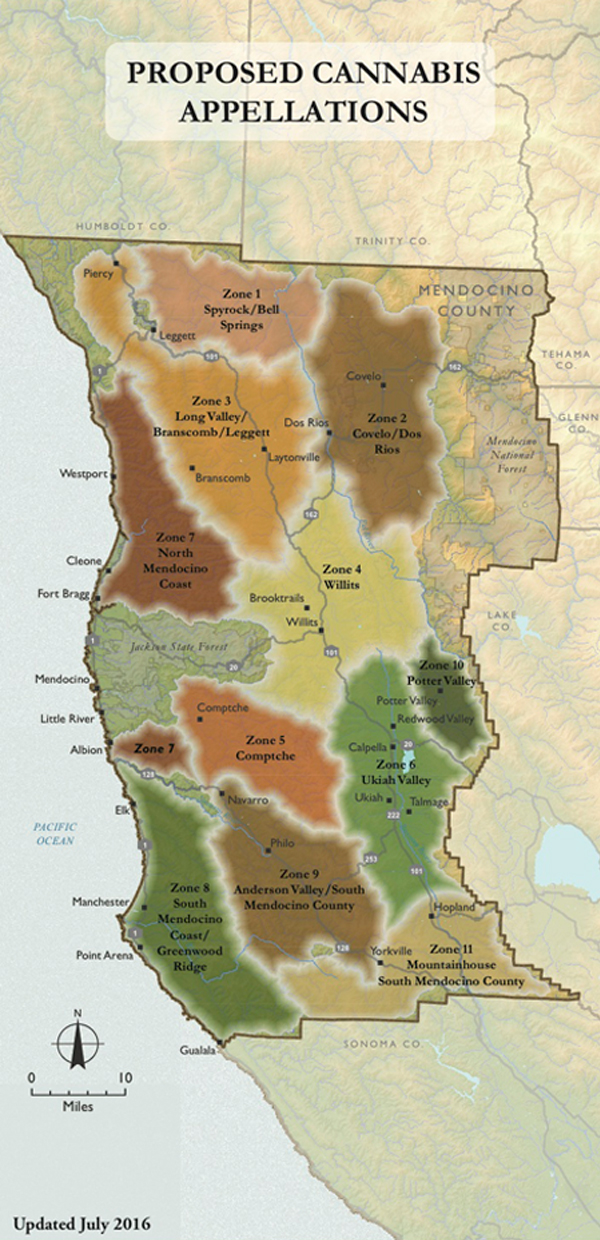Good wine and good weed might have more in common than you think. Not only are both widely grown under the sun in Northern California, but thanks to cannabis farmer Justin Calvino, both are now distinguished by their appellations — a way of communicating an agricultural product’s origin story to the marketplace. That includes its terroir, or the region, climate, and other environmental factors that influence its cultivation. Legally defined by geography, appellations go on a product’s label to indicate its superior quality.
Calvino, a board member of the California Growers Association, founded the Mendocino Appellations Project in 2015. According to the project, “appellations of origin” are a type of intellectual property that fall under “geographical indication.” They are established via the collection and analysis of data specific to a region, informing the standards of the terroir certification. Once the criteria is established, a region can petition for an appellation certification based on a set of standards that appeal to an existing governing body that has an appellations program.
Historically, appellations have been used in France to distinguish high quality wines, cheeses, butters, and other agricultural products. Famous appellation products include Bordeaux wine or Prosciutto di Parma.
Today, the Mendocino Appellations Project distinguishes 11 regional zones and a proposed map. They designate not just regional and topographic terroir, but also cultural terroir: the socio-economic-political conditions guiding the northern California cannabis farmers’ lifestyle and agricultural practices.

“{The project} is proving that there’s a heritage tied to that agriculture. Here in the Emerald Triangle, that started with cannabis in terms of back to the land generation, and over the generations, there’s a legacy of genetic styles of cultivation,” says Genine Coleman, Mendocino Appellations Project manager. “For cannabis, because it’s an agricultural product born out of prohibition, there’s not a traditional approach.”
At the project’s heart, cannabis’ appellations represent a “cultural relationship to the land,” says Coleman. Things like volunteer fire departments or school districts drew cultivators out of the hills and into town, where they’d come together and exchange cultivation information and genetics.
The appellations take into account how the plant expresses its botanical qualities, as well as its chemical qualities: the terpene (aromatic chemical), cannabinoid (chemical compound), and flavonoid (phytonutrient and pigmentation) expression. “Essentially it’s a large research project to really explore regionally all those components of qualifiers and analyze the data, and from that data, a set of standards will emerge for a certification program,” says Coleman.
The appellations aren’t only about distinguishing high quality cannabis, but also proving that quality, she adds. “That’s a really valuable tool for small farmers who are facing essentially annihilation by industrialized production.” This kind of marketplace distinction can help to esteem outdoor grown, boutique cannabis cultivated by small farmers, rather than large scale companies. Moreover, they add value to cannabis tourism in northern California.
“It’s another way these farmers can survive, they can diversify their business plan and be a stop on a farm tour,” Coleman suggests. She also hopes that eventually, the appellations’ gravitas will help shape policy that protects the mom-and-pop cannabis farmer, the land, and their resources. “It’s a real challenge cultural, and so shaping policy that supports our appellations will support our communities,” Coleman says, “And the survival of our culture and our heritage.”





